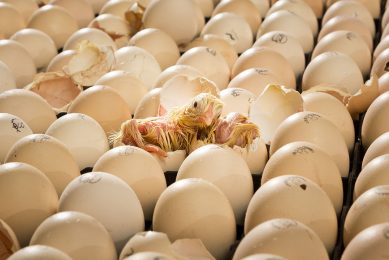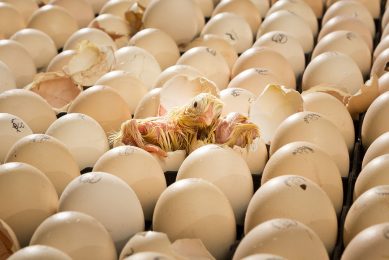Uniform incubation conditions optimise the hatch window

To obtain a good overall chick quality and uniformity in commercial hatcheries, chickens have to emerge from their eggshell in a time period up to 36 hours.
Furthermore, it is important that the chickens are maintained at an optimal temperature within the hatcher to prevent dehydration.
The time between the first and the last chicken that hatches is defined as the hatch window. There are several factors that influence the length of the hatch window, such as flock age, egg characteristics, storage time, and incubation conditions.
The environmental conditions inside the incubator affect the temperature that embryos experience. Temperature during incubation is one of the most important factors for embryonic development and chick quality. Not the temperature settings of the incubator, but the temperature the embryo experiences is important. Embryo temperature is difficult to measure without sacrificing the embryo. Therefore, eggshell temperature is used in practice as an indicator for embryo temperature. Eggshell temperatures within the range of 99.5 and 100.5°F until internal pipping have been shown to result in optimal hatchability and chick quality.
Eggshell temperatures
To maintain the eggshell temperatures within the range of 99.5 and 100.5°F, it is crucial that the environmental conditions within the incubator are uniform. When the conditions around the eggs at different location inside the incubator vary, eggshell temperatures are not uniform and probably drift outside the optimal temperature range. Non-uniform eggshell temperatures increase the variation in embryonic development and chickens will hatch over a longer period. This extends the hatch window and decreases uniformity.
In practice, carbon dioxide concentrations are sometimes increased at the end of incubation (>8.000 ppm) to narrow the hatch window in an incubator with non-uniform incubation conditions. In a normal situation, a decrease in oxygen and an increase in carbon dioxide in the air cell occur at the end of incubation as a result of the increase in metabolism of the embryo, and the restriction of the eggshell to provide enough oxygen and remove the excess of carbon dioxide of the air cell. The increase in carbon dioxide in the air cell triggers the embryo to pierce the air cell, start lung ventilation, and emerge from the eggshell. When the carbon dioxide concentration outside the egg is increased because of a lower ventilation rate of the incubator, this increases the carbon dioxide concentration in the air cell of the egg artificially. Comparable with the normal situation, the artificial increase in carbon dioxide in the air cell triggers the embryo to pierce the air cell and start the hatching process.
Narrow hatch window
The result of a high carbon dioxide concentration in the incubator at the end of incubation is that all chickens hatch within a narrow time window. The differences in hatching time that would have occurred as a result of non-uniform incubation conditions will diminish. However, a lot of chickens would not have hatched yet without the carbon dioxide stimulation and would have further grown and developed inside the egg, which increases chick development at hatch.
High carbon dioxide concentrations at the end of incubation are not necessary when incubation conditions are uniform throughout incubation. Therefore, the design of the incubator is crucial to obtain uniform incubation conditions, and especially, a uniform air flow and a high air velocity are important factors. Every egg in the incubator must be reached by the same air temperature, air velocity and relative humidity to obtain an optimal hatch window and good chick quality.
Author: Dr Roos Molenaar, HatchTech













